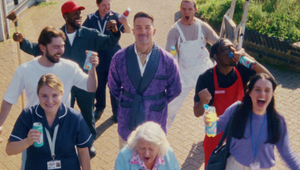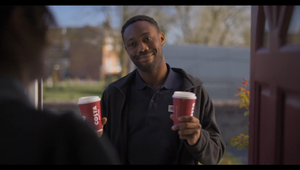
How the Metaverse Foundry Pressed Fast Forward on Sky’s Fortnite ‘Deathrun’

When UK broadband provider Sky wanted to convey the feeling of superfast - or ‘gigafast’ - speeds, they wanted to go beyond the usual marketing mix. They put slides into shopping centres, created elaborate bus shelter builds featuring giant Minions and even gave gamers a surprising speedy boost in the popular videogame Fortnite.
Brands heading into the popular battle royale shooter is nothing new in itself, but with this activation Sky was able to go deeper than a one-off event and create whole new game mechanics. Tapping into the craze for speed running, Sky created its own race complete with special speed boosts - and in doing so turned gameplay into a dimension of brand experience.
For the uninitiated, deathruns sees gamers race around specially-built obstacle courses - and it’s a phenomenon that has grown in popularity among streamers. And so Sky decided to give gamers a treat - a deathrun course that would really give them the ‘gigafast’ feeling. There’s also a few tantalising prizes on offer - a £5000 GAME voucher and the chance to race live against top streamer Ali-A.
This element of the campaign was forged into existence by Hogarth’s Metaverse Foundry, WPP’s specialist creative and production offering for all things metaverse. They worked closely with Fortnite developer Epic Games and their community and safety experts SuperAwesome.
According to Hogarth’s Global ECD Mehta Mehta, the driving principle was to give gamers what they actually wanted. “The challenge was: how do you make an authentic story? How do you keep it real and not annoy or piss off the community that’s in that space. We don’t want to put in any bad experiences and then just leave empty shells on their platforms,” says Mehta, who says that gaming, metaverse or web3 projects need to exist beyond the campaign cycle.
When the team looked at the speedrunning phenomenon, they immediately saw the connection with Sky Broadband’s offering - but to create something that would be relevant to gamers they needed more than that. They needed to give them something. By examining the behaviours and motivations behind players’ love of speedrunning, they identified that bragging rights and the competition to top leaderboards was a massive driver. By creative a ‘gigafast’ deathrun course, they gave gamers the chance to reach insane top speeds, throwing down the gauntlet.
“Those boosters actually changed this map from any other map,” explains Mehta. “There are many of these games and there’s the leaderboard globally. This one will always have the fastest time. So even if you are the fastest on X,Y, or Z course, have a go on this one - let’s see if you’re really fast, right?”
What’s more, the various speed boosters sprinkled throughout the course create a gaming experience and feeling that players won’t have experienced on other courses. Of course, monkeying about with game mechanics is a complicated business - get it wrong and you can completely break the game for players. In order to get it right, the team started with the map, figuring out how to make it different and where to build in the special moments and boosts. Crucially, says Mehta, then they worked really closely with the teams at Epic Games and Super Awesome to refine it and get the balance right.
“There was a lot of in-game learning from things they’d seen in comments in chats about what the players wanted to see and how they wanted it to feel. So, rather than reinventing the wheel, it was like, ‘what do they want and how do we build around that, and use the mechanics that really work?’ The things that didn’t work, faded out, and the ones that worked really well, we boosted,” says Mehta of the iterative approach.
From a creative perspective, the gameplay wasn’t the only delicate balancing act for the team. The Sky Broadband branding had to play nice with the Fortnite world, feel and aesthetics. Mehta notes that the Sky marketing team were really open to the need to be delicate and smart in this regard though he says he’s seen lots of brands that just ‘slap their logo and slap their message everywhere’.
“We have to be respectful to Fortnite, the Sky brand itself, the message of Gigafast. Juggling all these things, it was about being loud in certain places and then really subtle in others,” says Mehta.
For the creative team, the idea of taking the brand identity beyond the usual array of colour palette or logo and into the realm of gameplay was a really juicy challenge.
“We thought that since we can build products, let’s build something unique that actually adds to this game, and that’s actually part of the branding as well. That’s how you have to think about the Web 3 space. It can’t just be colours and 2D, flat thinking. It has to be 4D, where it tells the story that this is by Sky, it boosts the game and creates different engagements within the game.”
Thinking more generally, Mehta thinks that the project epitomises the Metaverse Foundry’s approach to helping brands figure out their place in the metaverse: creativity, community, and commerce. On creativity, they were able to figure out what they wanted to make - in this case an experience, though for other brands at other times it could be a product or service - and identify inventive ways to bring that to life. On community, understanding the existing Fortnite community and their desires, as well as listening to their feedback, allowed them to create something engaging and relevant. And finally, commerce - this could mean money, shops and NFTs but it could also relate to the exchange of ideas, but with this virtual race it was about the value of the novel experience, leaderboard bragging rights and the desirable prizes.
But beyond that, says Mehta, it shows that there’s plenty of opportunity to play about in the nascent metaverse space. “There is no rulebook. It’s just starting,” he says.















